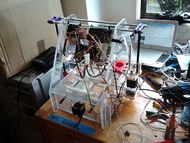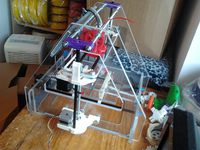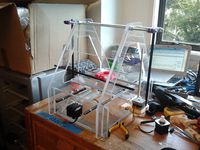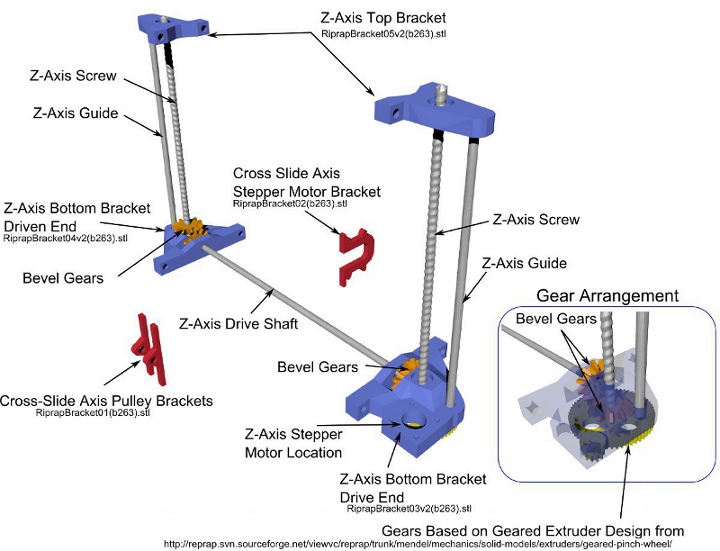Rroofl
Release status: Development
| Description | A Mendel variant designed specifically to be made in a FabLab
|
| License | GPL
|
| Author | |
| Contributors | |
| Based-on | |
| Categories | |
| CAD Models | |
| External Link |
"Don't like society? Print a new one." - Vik Olliver
Contents
Overview
This RepRap/RepStrap variant is designed to be produced in a FabLab, and yet to be sufficiently modular to produce using a variety of local manufacturing processes. It is rather unfriendly to the lone user in its present configuration, as it (a) will make use of all the available CNC-type devices in the workshop in parallel and (b) doesn't work yet. It sprang out of a 2-day session organised by User:VikOlliver and about a dozen hard-working volunteers at FabLab8 in Wellington, New Zealand. They are invited to add their names to the list when they find out about this page :)
Actual build volume currently envisaged 230mm x 230mm x 150mm. In reality there are some collision issues limiting X movement by 50mm or so above Z heights of more than about 60mm. The top of the arch needs to be thinner, the void in the side panels more generous at the top. Perhaps bringing the entire control panel (and thus stretching the void) towards the nearest narrow end?
Design Objectives
- Fabricate mechanical hardware in 1 person-day.
- Completely Open Source
- As many parts as possible to be able to use more than one fabrication technique.
- All routing cuts at least 6mm wide.
- No little extra bits to bolt on - minimize part count.
- If you do use bolts and threaded rod, either M3 (or 1/8") or M8 (or 5/16") please.
- If a zip tie or woodscrew does the job instead of 8 screws, 4 nuts and 16 washers, use one.
- Common parts only.
- Allow for lots of variation in hand-cut parts like the rods.
- Modular design that can be mass-produced, and modules used in other projects.
- Control systems capable of being scaled to drive other workshop equipment.
- Runs off 12-14V DC to be friendly to small, local, power generation systems.
- There is but One True Bearing: the 608Z "skateboard" bearing.
Current Status
X Axis uses the carriage from Simpleton prototype slightly hacked by a nice lady at Fab8nz, a NEMA17 and 3 x 608 bearings as corner pulleys. Tension in belt will draw under-constrained Z sliders onto Z guide rods. The unconstrained sliding portion of the carriage needs to clip more firmly onto the X rail and have slots at the idler end to allow the X rails to be pinned in place. End stop microswitch held in place by a single 2mm zip tie.Y axis fully assembled. 2mm zip tie used to hold end stop switch in place. Uses 5mm zip ties in the frame to hold both NEMA17 drive motor and the idler. Needs to be measured and the cutting files updated.
Z Assembled, currently using non-spec. gears. Sockets for 608 bearings were not deep enough, the waterjet cut holes in the frame to support Z brackets need to be +0.5mm diameter. The Z motor bracket needs to allow the motor to drop down an extra 3mm to mesh properly with the large driven gear.
There is no Z endstop in the design at present. Ideally the Z motor bracket should have some form of adjustable microswitch holder integrated with it. An actual, sliding, single 3D printed part, perhaps? :) It might be simpler to hold the Z endstop statically on the Z motor bracket, and add a length of M8 screw thread to the underside of the X motor bracket. The latter pokes the former when the X carriage descends too far.
The deposition bed is a simple piece of plastic sheet stuck down with double-sided foam, so it needs no fancy holes. Y carriage is in 2 identical parts joined with M8 rod. Y belt secured to carriage with zip ties, which also tension it.
It looks like we can drop all the holes in the lower part of the frame (and the top edge of both short ends) by about 15mm to increase our build height a bit. If we take another 5mm off the top edges we can claim that back for build height by dropping the height of the Y carriage a bit.
The circuit holding panel needs to move up and away from the build area, and needs a hole matrix for mounting Arduinos etc. on.
Electronics
Electronics for the steppers is assembled and in need of a rewiring. No extruder parts attached yet. All axes have actually moved, X & Y home correctly ...
Stepper motors are Sparkfun NEMA17's and some beefier ones scrounged from Massey University, Wellington. Drivers are a mix of EasyDriver V4's and Makerbot V3.3's and connect to an Arduino 1280 Mega using mostly commercial jumper leads. Connectors and lead lengths are a nightmare, so we need to rationalise this into something that suits the inventory.
There are no fixed or special electronics, though they must be designed to run of car batteries and donkey-powered generators etc. Not only does this make the printer capable of running on homebrew power, it ensures that they will continue to run in the event of natural disasters.
One option being explored is the use of an inexpensive breadboarding panel as a universal parts interface and bodging board. No soldering required and it encourages tinkering.
Zero endstops are all implemented with microswitches. a 10K resistor pulls the relevant input low, closing the switch makes it go high. There are no max limit switches.
Stepper motor STEP & DIR pins must not be longer than about 200mm.
When cable paths are established, we need mounting holes for cable ties so we can tidy them up.
A stepper motor module capable of driving 2A and made from FabLab inventory is being designed. Hopefully with sane connectors!
Spiral cable tidy is one option for constraining the cabling, and it is at least reusable.
Files
Please link or add your files here, folks.
Note that the Y axis brackets are replaced with zip ties in the prototype. If it works, why not? It looks likely that we will need to brace the frame across the top. In the prototype this is done with M8 threaded rod.
File:Rroofl Z-axis Blender files.zip The archive included here also contains the assembly model for checking gear meshes and interference. Refer to the image above for the filename corresponding to the bit you are interested in.
File:Rroofl Z-axis STLs.zip The image above will guide you to the appropriate model contained within this archive.
File:Y bed runners.scad The Y runners. It would be great if someone could vector this to cut on a laser Print two of these and join with a couple of 140mm lengths of M8 studding, nuts and washers. Ease the frame into shape on the rails before fully tightening. Y Slider legs can be compressed with a bolt or zip ties if it is necessary to level the bed.
File:Rroofl.inc Common measurements. Based on Simpleton's include file so lots of crap in it.
File:X axis bits.scad OpenSCAD file for the x-axis parts. Needs Rroofl.inc.
File:Printed rroofl stls.zip Contains printable STLs used in the prototype X, Y & Z axis.
Basic Rules of Engagement
Any rules or warnings that should be established before using the Rroofl can be included here. For example, a safety related tip would definitely make a good addition to this section (thanks for the reminder, OHM).
- Do touch, but touch responsibly.
- During assembly, look out for sharp bits of wire in the edge of the belt. They hurt.
- Do not ever unplug a stepper motor with the power on. It kills the driver.
Ongoing Development
There should be some more information here...
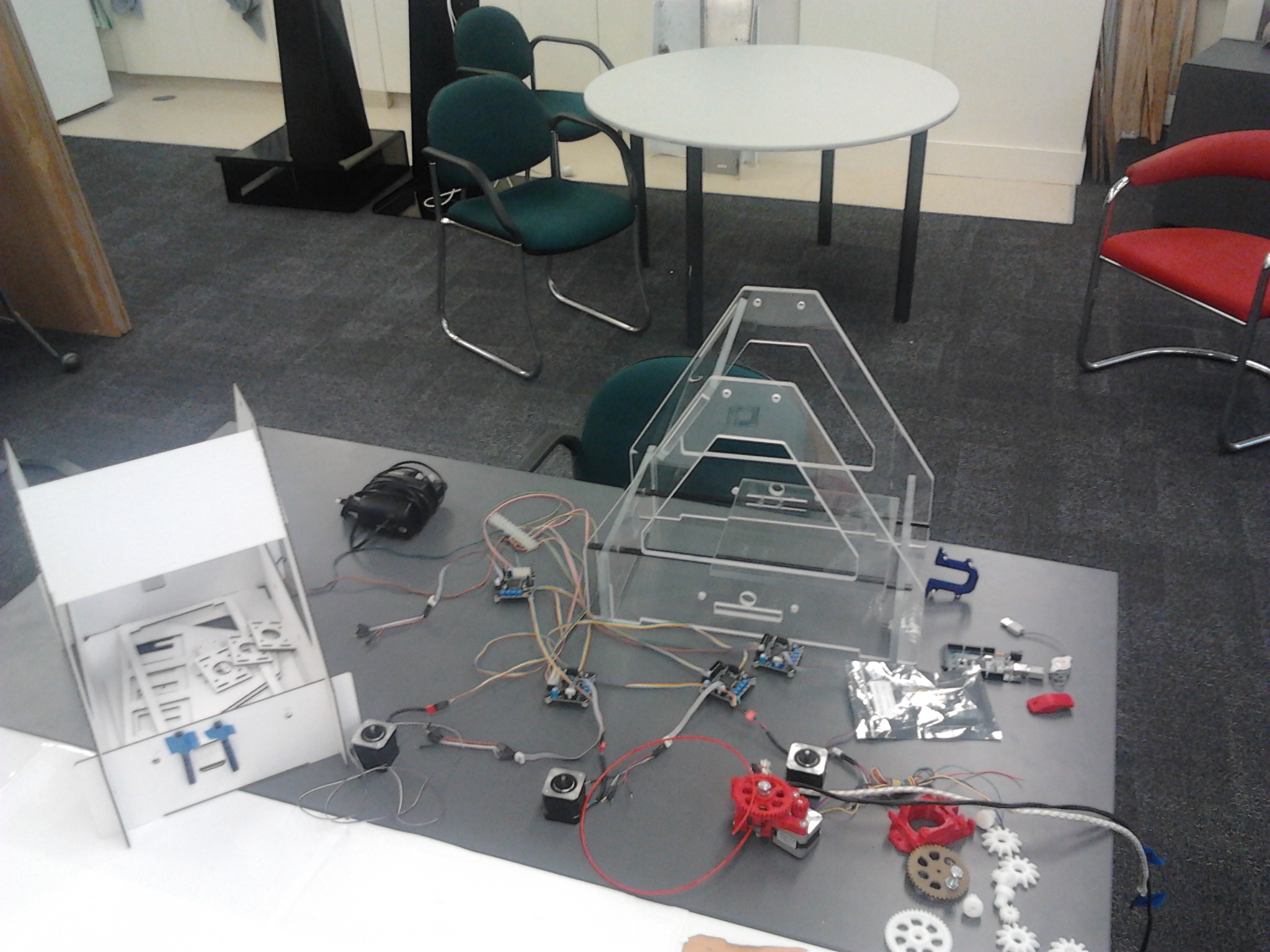 This is how it started at Massey University's FabLab during Fab8nz.
This is how it started at Massey University's FabLab during Fab8nz.
